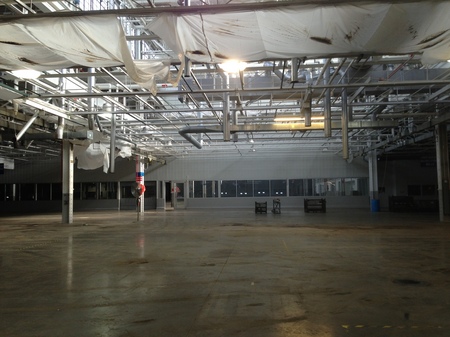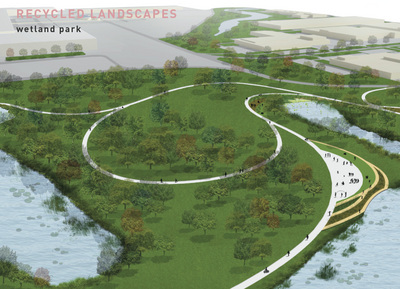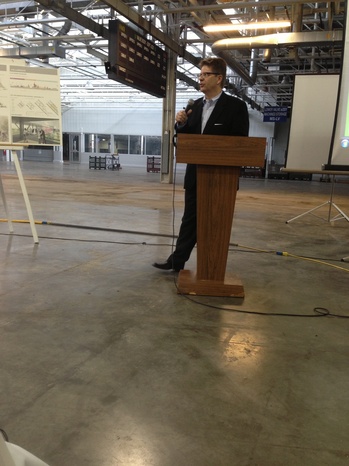
University of Michigan student Julie Cprek said the Willow Network research hub could produce next generation vehicle technology.
Courtesy photo
The former GM Powertrain Plant Facility and the Willow Run Airport could be the site of where the next cutting edge technology is created, according to University of Michigan students who spent the past several months creating three proposals for the sites.
A waste mining facility, an 'Energyopolis,' and a research hub known as the 'Willow Network' could be the future of the site according to the students. The students also presented findings on how to make the airport more energy efficient.
The three proposals follow a Tuesday announcement by the Yankee Air Museum to launch a $6 million campaign to buy the bomber plant — a 175,000-square-foot piece of the overall Powertrain property-- and an ambitious idea to create a $919 million rail system.
Students from the Taubman College of Architecture and Urban Planning, Ford School of Public Policy, School of Public Health, College of Engineering presented their proposals to community leaders, residents and local officials Thursday evening.
Cole Gehler, a U-M Masters of Urban Planning student, said the students began by doing research on the entire area and history of the property.
"The plant has shaped this site and region," Gehler said. "Essentially it was a small city... We have more people here and not the jobs this building can supply."
The plant closure decimated jobs in the area and disconnected the Willow Run area residents from the rest of the county. Gehler said the average resident has to access everything they need by driving a distance, however, the former plant property remains an asset for Washtenaw County.
Willow Network
U-M urban planning student Julie Cprek presented research regarding how the site could house a Willow Network, complete with a globally competitive research hub to promote collaboration and innovation in transportation research and development.

The Willow Network would be housed in the former GM facility.
Katrease Stafford | AnnArbor.com
"The Powertrain Plant is a large facility and it's going to allow for many vehicles to be tested," Cprek said. "It may provide testing space for unmanned vehicles."
Cprek said the network would be the site for research and testing of advanced transportation technologies.
Cprek said the site has several assets including the immediate access to the Willow Run Airport that could bring in people and goods from all over the world. The Powertrain Plant has high ceilings and wide bays that would create an ample amount of space for indoor testing. Cprek said that there's also more than 1,000 acres of underutilized, contiguous land that would provide developers with the necessary room to grow.
Cprek said a central testing facility could be created for prototyping, data collection and development. The testing facility would accommodated multiple driving industries and necessary commercial and manufacturing facilities that support product innovation and testing.
The network, according to research compiled by students from the School of Public Health, would have several effects including an increase in local and regional development, changes in nearby retail and an increase in construction and infrastructure jobs. The students said it could also provide a much needed boost to local land values within Ypsilanti Township.
Energyopolis
Why should a developer consider utilizing the property as an Energyopolis? According to the students, the state of Michigan spends $22.6 billion annually on energy resource imports, which they believe reinforces the need for renewable energy.
The students said the site would include five components: a science park, discovery center, a transit node, the West Willow neighborhoods and a park network, equipped with a running path, constructed wetland and other features.
Willow Run Airport
The Willow Run Airport and how it's utilized can and will affect the development at the plant, according to the students.
The airport is in the process of seeking $182 million in changes to its runways and infrastructure throughout the next 10 years.
Engineering student Zach Ogden said his team analyzed the airport's current capital expenditure plan and looked at the feasibility of creating a large solar panel installation that could potentially generate revenue.
Ogden said Sean Brosnan, director of the Willow Run Airport, was very interested in understanding the financial aspects of installing a solar field on the site to help offset costs.
Ogden said his team consulted industry experts and federal guidance from the FAA to determine the impact of a solar panel field that would completely offset the airport’s energy needs without impacting operations.
The initial cost to put in place a field of that size would be approximately $6 million, with yearly maintenance costs of $30,000, Ogden said, and the field would have an average life span of 25 years.

The rendering shows the wetland park with a waste sorting and mining facility in the background.
Courtesy photo
Ogden said it would be possible for the airport to possibly obtain funding from the FAA to cover most of the costs, except for about 5 percent of the $6 million.
Ogden said if funds from the FAA were to be secured, the field could create about $11.5 million in new and available revenue for the airport, while also transforming it into a producer of clean energy for the community.
"If you take grants into account, the airport is much more likely to break even," Ogdon said. "The airport is the cornerstone of the community. We want to have it known as a green airport."
Waste sorting and mining facility
According to the students, only about seven percent of southeast Michigan's waste is recycled. For this proposal, the students proposed partially demolishing the 5-million-square-foot facility to make way for a waste mining facility. The students also suggested creating a wetland park.
What's next for the property?
Paul Krutko, SPARK CEO, said his company is working with RACER Trust, the authority formed in the wake of GM’s bankruptcy in 2010 to market 89 GM sites across the country, to put a program in place at the site over the next several years utilizing some of the technology mentioned by the students in their proposals.

Paul Krutko
Katrease Stafford | AnnArbor.com
"We're looking for users that are going to grow the economy," Krutko said. "(This site) could be a tremendous national asset. We think that what we develop here could respond to global challenges... This could be an example of sustainable economic development."
Grant Trigger, Cleanup Manager for the former GM properties in Michigan, said he is also responsible for coordinating demolitions for RACER Trust.
"We are on course right now to demolish the facility," Trigger said.
Yet, if potential proposals pan out, like the Yankee Air proposal and others, Trigger said RACER would likely portion off parts of the property from demolition.
"We’re still pursuing and engaging in discussions with potential developers of portions of the site," Trigger said. "If those agreements came together then we could exclude those from the demolition...Without the user you really can't sustain the facility."
Bruce Rasher, redevelopment manager for RACER Trust, said while they would consider possibly retaining the building, the trust convened a series of meetings over the past year with officials, who suggested demolition was the way to go.
"The trust was told conclusively that it is highly improbable that it would be cost friendtly to reuse the buildings at the site," Rasher told AnnArbor.com. "If the trust and the community have a hope to attract new investment, the trust really needs to offer to the market a site that’s been clear and ready for development and the building is actually serving as an impediment."
Rasher said realistically, the trust is looking for developers interested in using the property for manufacturing and supply chain logistics that would serve markets throughout southeast Michigan.
Rasher said he is confident the property will be redeveloped soon and so far, RACER has been in discussions with 50 entities. The building was assessed at $16,284,900, making its market value more than $32 million, according to the property's marketing brochure.
"This is a very valuable piece of property because of it's size," he said. "...We are confident the trust will be able to attract an investor that will create jobs." Katrease Stafford covers Ypsilanti for AnnArbor.com.Reach her at katreasestafford@annarbor.com or 734-623-2548 and follow her on twitter.